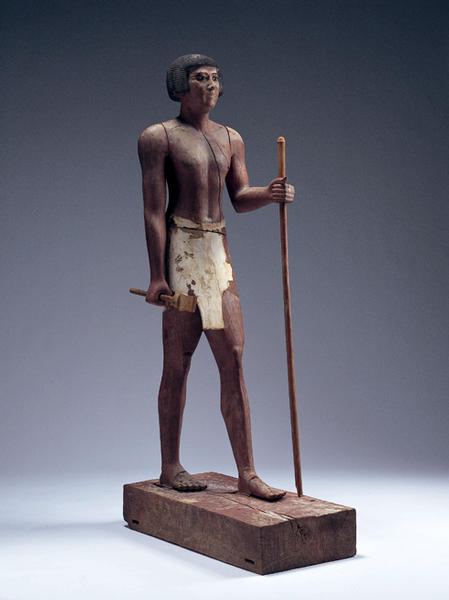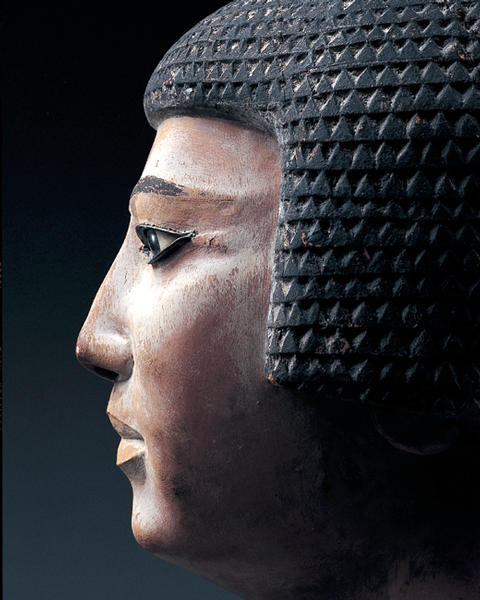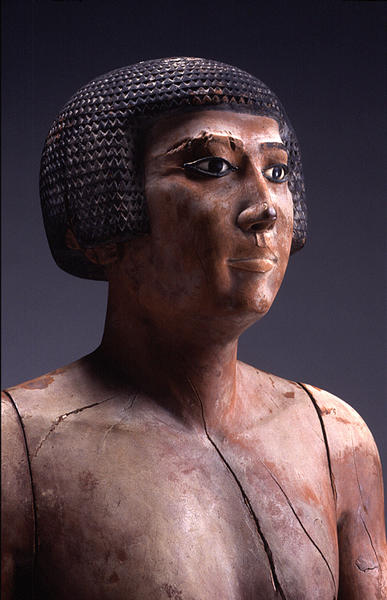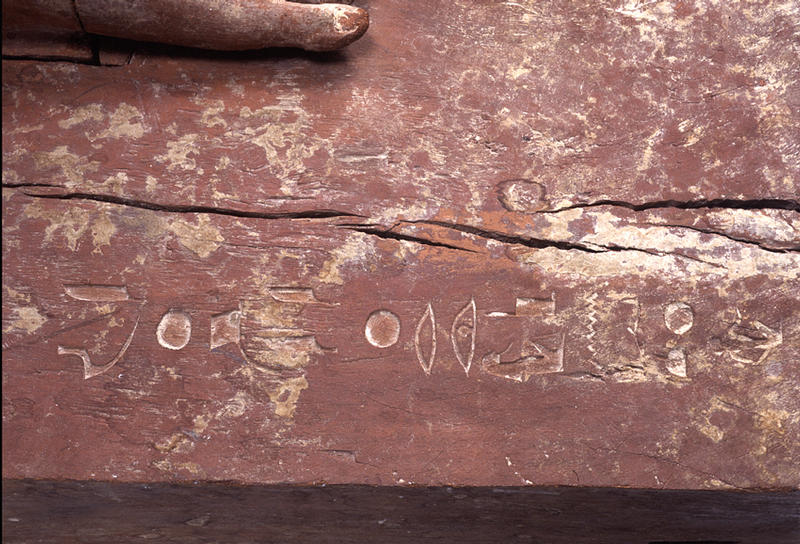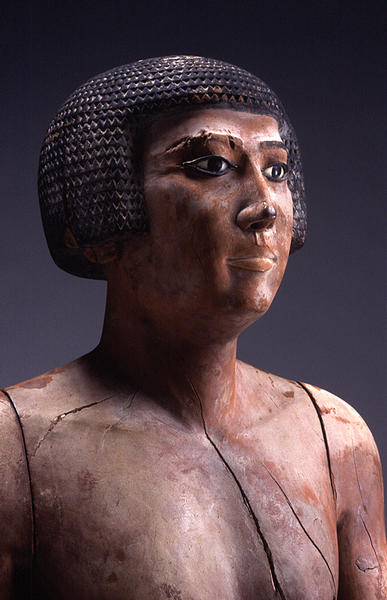ナクト像
- エジプト
- エジプト中王国第12王朝時代前期
- 前1960-前1916年頃
- アカシア、石膏に着彩、目と乳頭は象嵌
- H-152
- 所蔵
- アシュート出土
この等身大の木彫像はナクトと呼ばれる人物のために作らた。それは冥界の最高神オシリスにあやかったアカシア樹の二股の枝を両足に、それを纏める幹を頭部と胴体にあてはめたものであり、死者のkaと呼ばれる一種の守護霊が宿るものとして若く美形に造形されている。幹をそれにあてがったためか、その胴体はやや細まった印象をうけるが、このプロポーションは当時の彫刻や平面の人物図像の傾向にも通じている。
この等身大の木彫像はナクトと呼ばれる人物のために作らた。それは冥界の最高神オシリスにあやかったアカシア樹の二股の枝を両足に、それを纏める幹を頭部と胴体にあてはめたものであり、死者のkaと呼ばれる一種の守護霊が宿るものとして若く美形に造形されている。幹をそれにあてがったためか、その胴体はやや細まった印象をうけるが、このプロポーションは当時の彫刻や平面の人物図像の傾向にも通じている。
この等身大の彫刻は、頭部から脚部まで一本の木の幹で作られている。二股に分かれた枝が足にあたり、左足を前に出した歩行の姿勢をあらわしている。左手に杖、右手に杓を持ち、短いかつらをかぶり、シェンディトといわれるスカートをはいている。体と台座には褐色、かつらと眉毛には黒色の絵の具が木の表面に直接塗られているが、スカートは、石膏と無地の亜麻布を二重かけた上に白色の顔料が塗られている。そのため、実際のスカートをはいているように見える。左目は瞳を黒石、眼球を白石で象嵌されている。台座には、「オシリスに祝福を受けし者、ナクト」と記されている。
この木彫像には「オシリスに祝福されし者ナクト」という銘文が彫られ、死者ナクトに対し所定の葬送儀礼が滞りなく行われたことを示している。この像の異例な保存の良さが疑問視されて来たが、体躯の木材と体表面に施された顔料の溶剤のC14分析によってこれが作られてから四千数百年たっている事が算定された。この像本体の頭部から踵までは一本のアカシア材から彫りだされているが、二又に枝分かれしたアカシア樹を逆さに使い、幹部を頭部から腰の部分に、枝別れした部分を開いた両脚にあてはめている事がわかる。同様に杖をつく左腕も腕を曲げた通りの角度に曲がっている。これはまさにこの像にふさわしい形状に生え育ったアカシア樹が選ばれ使用されたことを示している。
どこに祀られたか
古代エジプトの墓(マスタバ)の構造は、死者を葬った地下の玄室から地上まで小さな穴が開けられ、地上の部分は石でこれを塞いだものでしたが、この地上の構築物は「kaの家」と呼ばれました。
このkaの家の礼拝所の奥の閉ざされた部屋(serdab)にka像が置かれました。
この部屋の扉は実際には開かず「偽扉」と呼ばれていますが、しばしばその上部には小さな窓が開けられ、それを通して遺族は「ka」を拝むことができました。
中王国(前21-17世紀)のテキストによると「ka」は、マスタバのみならず個人の家の神殿、もしくは屋根裏の礼拝所、そして庭にも置かれ、拝まれたと言われています。
ウェパイ像
なぜ作られたのか
この像はおよそ四千年の歳月を経ていますが、風化の感じられない、まだその木の香も残っていそうな木彫像です。
この木彫像はカァ(ka)像と呼ばれています。エジプトでは一人の人間が生まれる時kaもその「二重身」として生まれ、死後もそれは生き続け供養を必要としたのです。それは個人を生かす活力を与えるものと考えられていたようです。
通常、墓の地下にはその人の遺体を葬ったのですが、そのkaを象った像を遺族は地上のチャペルの奥に祀り、供物を捧げました。事情の許さない時はそのチャペルの内壁に浅浮彫等で描かれた供物が代用として考えられたのです。
ka像は墓のみに収められたのではなく、しばしば家にも祭られたと言われていますが、特にこの像が造られた第十二王朝頃よりkaに対する供養は日々あるいは定期的になされるようになりました。
後世の文献資料から考えて、それはある意味で霊界の主神オシリスの審判における守護霊と見做されるようになったのであると言われています。
ウェパイ像
ナクト像の特徴
この像の台座には「オシリスにより祝福されしものナクト」というヒエログリフの銘文が見られ、右手には王から権力を委任されている徴のセケムと呼ばれる笏を持っています。
ナクトは第十二王朝(紀元前1991~1783年)頃の人物であると考えられていますが、本来王が身に付けるキルトをまとっているところを見ると、身分の高い人物であり、遺族によって手厚く葬られたことが想像されます。しかもこの像は大変足が長く、しかも痩せず太らず均整を保っており、顔も大変理想化され個性的表現とは異なった美しさがあります。
どうやって作られたか
この等身大のナクト像は両腕と両足の爪先を除き、全て一本の樹木によって作られています。それも古王国以来のものに見られるような大きな木の塊から彫りだしたものではなく、木の繊維の流れを見ると、二又にわかれた木を逆さに使い胴体と二本の足にあてはめたのです。
そのせいか全体のバランスを見ると、その胴体特に胸部と腰の部分は幾分細く作られています。杖を持つほぼ直角に曲がった左腕の繊維も、肘の部分で腕の曲がり方と同様にほぼ直角に向きを変えています。この腕もその形の通りの木から彫りだしたものと考えられます。
この像はアカシアで作られていますが、アカシアは古来船を作る重要な材料として使われ、また黄泉の国へ死者を渡す神聖な樹木として敬われました。
この十二王朝頃からka像の供養が盛んになって行きましたが、それは高官の力が強くなって行く一方で、それまで王と神にしか許されなかった天国が、オシリスの審判次第では高官にも許されるものと考えられるようになったと言われています。つまりその審判ではオシリスに近似することが絶対的な要件だったのです。
同時代人物像の傾向
この中王朝時代(第11王朝~第14王朝/2040-1640B.C.)に彫刻や絵画の人物像におこった大きい変化は胴体が細くなったことです。
肩幅も狭くなり全体に引き伸ばされたような姿となりました。この時期の作品には質的に大変なばらつきがあると言われますがナクト像の胴の細さはやはり引き伸ばされた雰囲気を持ち、臍の位置が高く、腰が細く、胴部に比較して脚部の比率が高くなっています。
おもしろいことにこれは壁面のレリーフの図像を中心に行った分析であり、彫刻にもその同じ傾向が伺える事が分かります。
Gay Robins/ Proportion and Style in Ancient Egyptian Art/ Texas 1994;
死者の書のka
「我がheart,我がmother --審判にあってはなにものも我に抗するものなきよう-- 汝は我がka 我がうちにありて四肢を強くせし-- 我が進むべき至福の庭に先立ちて導かれんことを-- Shenit(冥界の神的存在の一つ)が神の御前で我が名に汚れを着せず、我に抗がう偽りを言いたてることなきよう。--」
Book of the Dead XXXB
このように新王国(16th-11thC.B.C.)頃の「死者の書」によれば、[我を産み出せしBreast]とも呼ばれるkaに対し審判において味方をするよう懇願しています。
これはkaが何か、個人とは独立した一種の規律のようなものと見做されていたことを示していると考えられます。
かつては天国は神々と王のみに許されていましたが、中王国時代頃より官僚(神官)や身分の高い人々にもそれは開かれるようになり、彼等の通過しなければならない審判の重要性が目立ってきたものと考えられます。
ウェパイ像
エジプトのしゃれ
例えば太陽神ラアの眼から流された涙から人間が育ったとするエジプト神話に対しそれが言葉の 遊びであろうと言われています。
それはエジプト語の人間
エジプト人は似た言葉の指すものの本質は類似していて、この類似性は世界の調和を示していると考えていたものと思われます。
同様にこのアカシアの樹
聖なるアカシア樹
下エジプトのヘリオポリスの北では、聖なるアカシア樹の下で神々が生まれたとされています。
ピラミッドテキスト(436)によればホルスはアカシアから現われたとされています。
後にアカシアは誕生とともに死にも結び付けられ、死者の書(125アニのパピルス)では死者は子孫の(用意した)アカシアで(黄泉の国への)道を作った(導かれた)と言う記述があります。
スリムな彫像
体をスリムに表現する顕著な傾向は、同時代の図像およびいくつかの彫像に見られますが、関連のルーヴルの同じ名前を持った像(E26915/Hapidjefai、E11937/Le Chancelier Nakhti)も大変類似したスリムなプロポーションを持った彫刻で、大きなアカシア樹の塊を使用しています。
古王国では細身のプロポーションを持った像が、小さい材を使った安価なものであったとする説はこの第12王朝には適応出来ないと考えられます。
同時代の入念な彫刻を施した像にアカシア製が多いことも注目に値します。
参考図書
1.Musee du Louvre/ Statues egyptiennes du Moyen Empire/ Paris 1987
2.Gay Robins/ Proportion and Style in Ancient Egyptian Art/ Texas 1994
3.William C.Hayes/ The Scepter of Egypt I/ New York 1953
同時代の傾向
紀元前三千年代に上下エジプトの統一が行われて以来、その美術の様式も確立され、以後ほぼ三千年にわたりあまり大きな変化を見せなかったエジプト美術ですが、その人物のプロポーションにはいくらかの変化があったことがわかっています。
それは未完成の壁面レリーフ、壁画、そして彫刻などに引かれた升目によってわかってきた事です。
この中王朝時代(第11王朝~第14王朝/2040-1640B.C.)に彫刻や絵画の人物像におこった大きい変化は胴体が細くなったことだと言われています。
肩幅も狭くなり全体に引き伸ばされたような姿となりました。
この時期の作品には質的に大変なばらつきがあると言われますがナクト像の胴の細さはやはり引き伸ばされた雰囲気を持ち、臍の位置が高く、腰が細く、胴部に比較して脚部の比率が高くなっています。
おもしろいことにこれは壁面のレリーフの図像を中心に行った分析であり、彫刻にもその同じ傾向が伺える事が分かります。
Gay Robins/ Proportion and Style in Ancient Egyptian Art/ Texas 1994;
Catalogue Entry
The statue of Nakht is a rare and beautiful example of life-size wooden sculpture from the Middle Kingdom Period of ancient Egypt.1
Nakht appears in the classical striding pose for men, left foot advanced, and holding a staff in his left hand and a scepter in his right. He wears a short, curled wig and a short kilt with central tab in front. This type of kilt, called a shendyt, was originally a royal prerogative, but by Nakht's time it had been adopted by private people (but only in their tomb representations).
The flesh areas and base of the statue are painted reddish brown. The wig and eyebrows are painted black. These pigments have been applied directly to the wood. The white of the kilt, though, is painted over gesso. Between the gesso and the white pigment layer are two layers of plain-woven linen. The added layers of linen and gesso help to create the impression of a garment actually worn.
Nakht's face is square, with a low forehead. The nose is short and straight. The philtrum is well defined. The lips are full, but not thick, and encircled by a thin ridge, or lipline. He has high cheekbones and full cheeks. The jawbone is strong and angular, the chin slightly bulbous. Eyebrows and cosmetic lines are modeled in low relief. The left eye is inlaid. Its pupil is of black stone, the eyeball of white stone, and the eyelids of copper. (The right eye is modern, the original having been pried out, with some resulting damage to the lid and eyebrow.) The neck muscles and clavicles are carefully and naturalistically rendered. In contrast to the naturalism of the rest of the features, the earlobes are summarily treated as flat disks. This appears to be related to the type of wig.
Nakht's body is that of a young man in prime physical condition. The musculature is well developed, but not exaggeratedly so. A median line bisects the torso above the navel. The right nipple is inlaid, the left one is missing.
Despite losses of paint and gesso and cracks in the wood, the statue is in fine condition. The head, torso, and legs were carved from the trunk of a single tree. The arms, kilt tab, fronts of the feet, left heel, base, staff, and scepter were made separately. The arms are attached to the figure by mortise-and-tenon joints. The tab of the kilt is fastened by a dowel. Massive tangs beneath the feet fit into sockets in the base. Wedges in the sockets keep the figure steady. The fronts of the feet are doweled to the base. (The statue was sawn in half in modern times, as evidenced by the modern saw marks with no trace of weathering in the cut. This has nothing to do with how the statue was made.)
The base is inscribed, "the one honored by Osiris, Nakht." And that is all we know about him. To be "honored by Osiris" the god of the dead, meant that a person had been provided with a proper burial, equipped with everything necessary for a successful passage to the afterlife. Judging by the size and superb quality of this statue, Nakht's burial must have been splendid indeed.
A curious feature of this statue is the presence of incised figures of divinities inside the shoulders on the flat surfaces of the torso where the arms are attached. Naturally, these figures are not visible when the statue is assembled. The purpose of these figures is not certain, but it is likely that they served a magical protective function.
Only about a dozen comparable statues have survived from the Middle Kingdom. Some are as large as--even larger than--Nakht, some are as well preserved, but none surpasses it as a work of art. The most famous is the statue of Chancellor Nakht (no relation) in the Louvre. This statue was discovered in 1903 by the French archaeologists Emile Chassinat and Charles Palanque at Asyut, 407 kilometers upstream from Cairo.2 A second statue of Chancellor Nakht is in the Egyptian Museum, Cairo.3 These two large wooden statues stood facing each other in the tomb chapel, where they would have been seen and admired by visitors. The Shumei statue would presumably have been displayed in a similar manner. From the same excavations as Chancellor Nakht came the statues of Ankhef in Cairo4 and Wepwawetemhat in the Museum of Fine Arts, Boston.5
Between 1905 and 1908, the Italian archaeologist Ernesto Schiaparelli carried out four seasons of work at Asyut. As a result, the Egyptian Museum of Turin has six wooden statues of the type under discussion, more than any other museum. At 210 centimeters in height, the statue of Djefahapy is the largest of all.6 Other wooden statues in Turin include two statues of Minhotep,7 one of Shemes,8 one of Wepwawetemhat, and one with missing base (and consequently anonymous, as the name is invariably inscribed on the base).9 From the same excavations is a large wooden statue in Cairo, also missing its base.10
Closest in style to Nakht is the 205-centimeter-tall statue of Djefahapy in the Louvre.11 Formerly in the collection of Sayed Pasha Khashaba, the statue was discovered in 1913 or 1914 by Ahmed Bey Kamal in the piled-up debris south of Djefahapy's tomb, also at Asyut.12 This Djefahapy is famous among Egyptologists for ten inscriptions in his tomb, including ten contracts with various priests providing for the maintenance of his funerary cult, including the care and feeding of his statues.13
All of the parallels for Nakht come from Asyut. All but the Louvre statue of Djefahapy come from tombs that were discovered intact or relatively intact. Yet only the tomb of Djefahapy is securely dated by inscription, to the reign of Senwosret I (1960-1916 B.C.). The others have been variously dated to the First Intermediate Period (2123-2040 B.C.) and the Eleventh Dynasty (2040-1980), a period of about 150 years, although the recent trend has been to date them all to the Twelfth Dynasty (1980-1801 B.C.). This is based primarily on the texts and coffins,14 but also on the pottery and other finds. To date these tombs precisely it is necessary to consider the whole c
